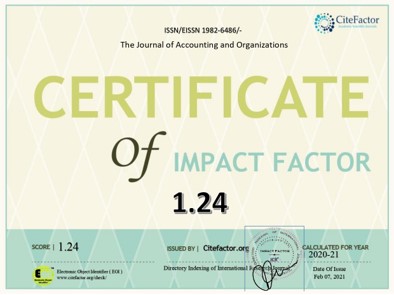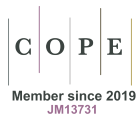Influência do sistema de mensuração de desempenho na agilidade organizacional e na inovação aberta
DOI:
https://doi.org/10.11606/issn.1982-6486.rco.2022.193897Palavras-chave:
Sistema de mensuração de desempenho, Agilidade organizacional, Inovação aberta, Empresas brasileirasResumo
Este estudo analisar a influência do sistema de mensuração de desempenho na agilidade organizacional e na inovação aberta. O processo de coleta dos dados foi efetuado com gestores de empresas brasileiras listadas na Brasil, Bolsa, Balcão (B3). Foram obtidas 105 respostas válidas, e analisadas por meio da técnica de modelagem de equações estruturais. Os resultados mostram que o sistema de mensuração de desempenho interativo influencia positivamente na agilidade organizacional e na inovação aberta. Os achados revelam ainda que a agilidade organizacional medeia a relação entre o sistema de mensuração de desempenho interativo e a inovação aberta. Essas evidências contribuem para a literatura gerencial ao sugerir a agilidade organizacional como um fator importante (mediador) que reforça os efeitos do PMS na inovação aberta. Além disso, avança ao mostrar que a implementação de PMS interativo é um importante antecedente da inovação aberta.
Downloads
Referências
Anzilago, M., Gomez-Conde, J., & Lunkes, R. J. (2022). How do Managers use Management Control Systems in Response to Shareholder Activism? European Accounting Review. https://doi.org/10.1080/09638180.2022.2063152
Anthony, R. N. (1965). Planning and control systems: a framework for analysis. Division of Research, Graduate School of Business Administration, Harvard University.
Bedford, D. S. (2015). Management control systems across different modes of innovation: Implications for firm performance. Management Accounting Research, 28, 12-30. https://doi.org/10.1016/j.mar.2015.04.003
Bedford, D. S., Bisbe, J., & Sweeney, B. (2019). Performance measurement systems as generators of cognitive conflict in ambidextrous firms. Accounting, Organizations and Society, 72, 21-37. https://doi.org/10.1016/j.aos.2018.05.010
Bedford, D. S. (2020). Conceptual and empirical issues in understanding management control combinations. Accounting, Organizations and Society, 86, 101187. https://doi.org/10.1016/j.aos.2020.101187
Bisbe, J., & Otley, D. (2004). The effects of the interactive use of management control systems on product innovation. Accounting, Organizations and Society, 29(8), 709-737. https://doi.org/10.1016/j.aos.2003.10.010
Biswas, S. S. N., & Akroyd, C. (2022). Management control systems and the strategic management of innovation. Qualitative Research in Accounting & Management. https://doi.org/10.1108/QRAM-04-2021-0083
Breunig, K. J., Aas, T. H., & Hydle, K. M. (2014). Incentives and performance measures for open innovation practices. Measuring Business Excellence, 18(1), 45-54. https://doi.org/10.1108/MBE-10-2013-0049
Broadbent, J., & Laughlin, R. (2009). Performance management systems: A conceptual model. Management Accounting Research, 20(4), 283-295. https://doi.org/10.1016/j.mar.2009.07.004
Capon, N., Farley, J. U., Lehmann, D. R., & Hulbert, J. M. (1992). Profiles of product innovators among large US manufacturers. Management Science, 38(2), 157-169. https://doi.org/10.1287/mnsc.38.2.157
Chakravarty, A., Grewal, R., & Sambamurthy, V. (2013). Information technology competencies, organizational agility, and firm performance: Enabling and facilitating roles. Information Systems Research, 24(4), 976-997. https://doi.org/10.1287/isre.2013.0500
Chenhall, R. H., & Moers, F. (2015). The role of innovation in the evolution of management accounting and its integration into management control. Accounting, Organizations and Society, 47, 1-13. https://doi.org/10.1016/j.aos.2015.10.002
Chesbrough, H. W. (2003). Open innovation: The new imperative for creating and profiting from technology. Harvard Business Press.
Cockburn, I. M., & Griliches, Z. (1988). Industry effects and appropriability measures in the stock markets valuation of R&D and patents. American Economic Review, 78(2), 419-423.
Curtis, E., & Sweeney, B. (2017). Managing different types of innovation: mutually reinforcing management control systems and the generation of dynamic tension. Accounting and Business Research, 47(3), 313-343. https://doi.org/10.1080/00014788.2016.1255585
Ferreira, A., & Otley, D. (2009). The design and use of performance management systems: An extended framework for analysis. Management Accounting Research, 20(4), 263-282. https://doi.org/10.1016/j.mar.2009.07.003
Flamholtz, E. G., Das, T. K., & Tsui, A. S. (1985). Toward an integrative framework of organizational control. Accounting, Organizations and Society, 10(1), 35-50. https://doi.org/10.1016/0361-3682(85)90030-3
Frare, A. B., da Cruz, A. P. C., Lavarda, C. E. F., & Akroyd, C. (2021). Packages of management control systems, entrepreneurial orientation, and performance in Brazilian startups. Journal of Accounting & Organizational Change. https://doi.org/10.1108/JAOC-04-2021-0052
Gerdin, J. (2020). Management control as a system: Integrating and extending theorizing on MC complementarity and institutional logics. Management Accounting Research, 49, 100716. https://doi.org/10.1016/j.mar.2020.100716
Geroski, P. A. (1995). Market structure, corporate performance, and innovative activity. OUP Catalogue.
Gould, R. (2012). Open innovation and stakeholder engagement. Journal of Technology Management & Innovation, 7(3), 1-11. http://dx.doi.org/10.4067/S0718-27242012000300001
Grabner, I., Posch, A., & Wabnegg, M. (2018). Materializing innovation capability: A management control perspective. Journal of Management Accounting Research, 30(2), 163-185. https://doi.org/10.2308/jmar-52062
Grafton, J., Lillis, A. M., & Widener, S. K. (2010). The role of performance measurement and evaluation in building organizational capabilities and performance. Accounting, Organizations and Society, 35(7), 689-706. https://doi.org/10.1016/j.aos.2010.07.004
Hair Jr, J. F., Sarstedt, M., Ringle, C. M., & Gudergan, S. P. (2017). Advanced issues in partial least squares structural equation modeling. Sage Publications.
Harlez, Y., & Malagueno, R. (2016). Examining the joint effects of strategic priorities, use of management control systems, and personal background on hospital performance. Management Accounting Research, 30, 2-17. https://doi.org/10.1016/j.mar.2015.07.001
Henri, J. F. (2006). Organizational culture and performance measurement systems. Accounting, Organizations and Society, 31(1), 77-103. https://doi.org/10.1016/j.aos.2004.10.003
Henri, J. F., & Wouters, M. (2020). Interdependence of management control practices for product innovation: The influence of environmental unpredictability. Accounting, Organizations and Society, 86, 101073. https://doi.org/10.1016/j.aos.2019.101073
Huang, H. C., Lai, M. C., Lin, L. H., & Chen, C. T. (2013). Overcoming organizational inertia to strengthen business model innovation: An open innovation perspective. Journal of Organizational Change Management, 26(6), 977-1002. https://doi.org/10.1108/JOCM-04-2012-0047
Liao, S., Liu, Z., & Ma, C. (2019). Direct and configurational paths of open innovation and organisational agility to business model innovation in SMEs. Technology Analysis & Strategic Management, 31(10), 1213-1228. https://doi.org/10.1080/09537325.2019.1601693
Lill, P., Wald, A., & Munck, J. C. (2021). In the field of tension between creativity and efficiency: a systematic literature review of management control systems for innovation activities. European Journal of Innovation Management, 24(3), 919-950. https://doi.org/10.1108/EJIM-11-2019-0329
Lu, P., Yuan, S., & Wu, J. (2017). The interaction effect between intra-organizational and inter-organizational control on the project performance of new product development in open innovation. International Journal of Project Management, 35(8), 1627-1638. https://doi.org/10.1016/j.ijproman.2017.09.009
Malmi, T., & Brown, D. A. (2008). Management control systems as a package — Opportunities, challenges and research directions. Management Accounting Research, 19(4), 287-300. https://doi.org/10.1016/j.mar.2008.09.003
Merchant, K. A., & Otley, D. T. (2007). A review of the literature on control and accountability. Handbooks of Management Accounting Research, 2, 785-802.
Mannes, S., & Beuren, I. M. (2021). Influência da capacidade de rede e do compartilhamento de informações e de conhecimento na inovação aberta. Advances in Scientific and Applied Accounting, 14(2), 164–178/179. https://doi.org/10.14392/asaa.2021140207
Mannes, S., Frare, A. B., & Beuren, I. M. (2021). Efeitos do uso dos orçamentos estático e flexível na inovação de processos e produtos. Revista de Contabilidade e Organizações, 15, e180829-e180829. https://doi.org/10.11606/issn.1982-6486.rco.2021.180829
Mikalef, P., & Pateli, A. (2017). Information technology-enabled dynamic capabilities and their indirect effect on competitive performance: Findings from PLS-SEM and fsQCA. Journal of Business Research, 70, 1-16. https://doi.org/10.1016/j.jbusres.2016.09.004
Moerloose, C. (2000). Turning innovation into success. European Business Forum, 1.29–35.
Monteiro, J. J., & Beuren, I. M. (2020). Efeitos do debate do sistema de mensuração de desempenho e do conflito cognitivo na inovação ambidestra. Revista de Contabilidade e Organizações, 14. https://doi.org/10.11606/issn.1982-6486.rco.2020.170418
Moulang, C. (2015). Performance measurement system use in generating psychological empowerment and individual creativity. Accounting & Finance. 55( 2), 519-544, 2015. https://doi.org/10.1111/acfi.12059
O’Sullivan, D., & Dooley, L. (2009). Applying Innovation. Sage Publications Inc., Thousand Oaks.
Pfister, J. A., Jack, S. L., & Darwin, S. N. (2017). Strategizing open innovation: How middle managers work with performance indicators. Scandinavian Journal of Management, 33(3), 139-150. https://doi.org/10.1016/j.scaman.2017.06.001
Simons, R. (1987). Accounting control systems and business strategy: An empirical analysis. Accounting, Organizations and Society, (12)4, 357–374, https://doi.org/10.1016/0361-3682(87)90024-9
Simons, R. (1990). The role of management control systems in creating competitive advantage: New perspectives. Accounting, Organizations and Society, 15(1-2), 127–143. https://doi.org/10.1016/0361-3682(90)90018-P
Simons, R. (1991). Strategic orientation and top management attention to control systems. Strategic Management Journal, 12(1), 49-62. https://doi.org/10.1002/smj.4250120105
Simons, R. (1995). Levers of control: How managers use innovative control systems to drive strategic renewal. Boston: Harvard Business School Press.
Simons, R. (2000). Performance measurement and control systems for implementing strategy. Upper Saddle River: Prentice Hall.
Teece, D., Peteraf, M., & Leih, S. (2016). Dynamic capabilities and organizational agility: Risk, uncertainty, and strategy in the innovation economy. California Management Review, 58(4), 13-35. http://dx.doi.org/10.1525/cmr.2016.58.4.13.
Trinh-Phuong, T., Molla, A., & Peszynski, K. (2010). Enterprise systems and organisational agility: Conceptualizing the link. 21st Australasian Conference on Information Systems.
Widener, S. K. (2007). An empirical analysis of the levers of control framework. Accounting, Organizations and Society, 32(7-8), 757-788. https://doi.org/10.1016/j.aos.2007.01.001
Downloads
Publicado
Edição
Seção
Licença
Copyright (c) 2022 Evellin Ramlow Brüggemann, Januário José Monteiro, Rogério João Lunkes

Este trabalho está licenciado sob uma licença Creative Commons Attribution-NonCommercial-NoDerivatives 4.0 International License.
A RCO adota a política de Acesso Livre (Libre Open Access), sob o acordo padrão Creative Commons (CC BY-NC-ND 4.0). O acordo prevê que:
- A submissão de texto autoriza sua publicação e implica compromisso de que o mesmo material não esteja sendo submetido a outro periódico. O original é considerado definitivo;
- Autores mantêm os direitos autorais e concedem à revista o direito de primeira publicação, com o trabalho simultaneamente licenciado sob a Licença Creative Commons Attributionque permite o compartilhamento do trabalho com reconhecimento da autoria e publicação inicial nesta revista;
- Autores têm autorização para assumir contratos adicionais separadamente, para distribuição não-exclusiva da versão do trabalho publicada nesta revista (ex.: publicar em repositório institucional ou como capítulo de livro), com necessário reconhecimento de autoria e publicação inicial nesta revista;
- Autores têm permissão e são estimulados a publicar e distribuir seu trabalho online (ex.: em repositórios institucionais ou na sua página pessoal) antes ou durante o processo editorial, já que isso pode gerar alterações produtivas, bem como aumentar o impacto e a citação do trabalho publicado (Veja O Efeito do Acesso Livre);
- A revista não paga direitos autorais aos autores dos textos publicados;
- O detentor dos direitos autorais da revista, exceto os já acordados no acordo de Libre Open Access (CC BY-NC-ND 4.0), é o Departamento de Contabilidade da Faculdade de Economia, Administração e Contabilidade de Ribeirão Preto da Universidade de São Paulo.
Não são cobradas taxas de submissão ou de publicação.
São aceitos até 4 autores por artigo. Casos excepcionais devidamente justificados poderão ser analisados pelo Comitê Executivo da RCO. São considerados casos excepcionais: projetos multi-institucionais; manuscritos resultantes da colaboração de grupos de pesquisa; ou que envolvam grandes equipes para coleta de evidências, construção de dados primários e experimentos comparados.
É recomendada a ordem de autoria por contribuição, de cada um dos indivíduos listados como autores, especialmente no desenho e planejamento do projeto de pesquisa, na obtenção ou análise e interpretação de dados e redação. Os autores devem declarar as efetivas contribuições de cada autor, preenchendo a carta ao editor, logo no início da submissão, responsabilizando-se pelas informações dadas.
É permitida a troca de autores durante todo o processo de avaliação e, antes da publicação do manuscrito. Os autores devem indicar a composição e ordem final de autoria no documento assinado por todos os envolvidos no aceite para publicação. Caso a composição e ordem de autoria seja diferente da informada anteriormente no sistema, todos autores anteriormente listados deverão se manifestar favoráveis.
No caso de identificação de autoria sem mérito ou contribuição (ghost, guest or gift authorship), a RCO segue o procedimento recomendado pela COPE.







